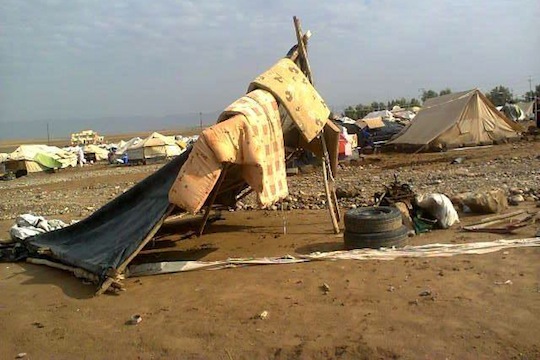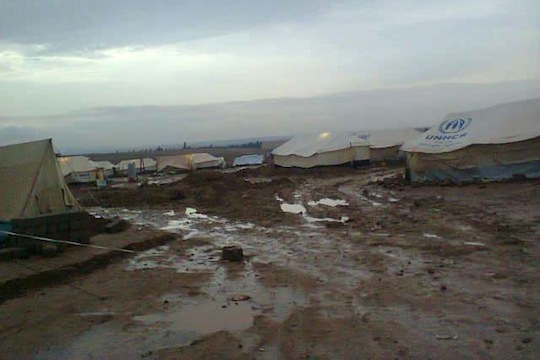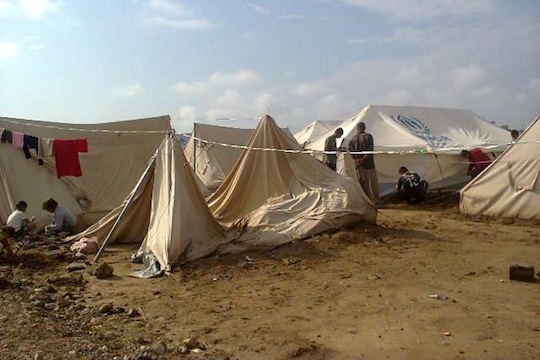Since the beginning of August, an estimated 350,000 Yazidi internally displaced persons (IDP) have been living in villages, towns and various refugee camps in Iraqi Kurdistan, Syria and Turkey. While most of those who found refuge have taken shelter in local school classrooms, construction sites or under bridges, the IDPs who have been placed in refugee camps were housed in tents, some of which were provided by the UN High Commissioner for Refugees (UNHCR).
Last week, as the first rains hit Iraqi Kurdistan, the Yazidi refugee camps quickly became mud traps. Should refugees not be put in caravans, these camps could potentially become the site of the next disaster to befall the Yazidis. Saad al-Avdal offers a first-hand account from Khanik, one of the largest and most densely populated refugee camps in Iraqi Kurdistan.
By Saad al-Avdal (translated by Idan Barir)
In the name of God, the compassionate, the merciful.
I do not know where or how to begin. I simply do not know. Let me start on August 3, 2014, that black and horrific day, when my family, as well as all the Ezidkhan [a general name for all Yezidi people] fell victim to genocide by the gangs of the Islamic State in Iraq and Syria (ISIS), to the abduction of women and children and to the ruthless killing of anyone who got in their way. On that day, all of us who escaped their filthy murderous hands, were forced to flee to Mount Sinjar (Shingal) and stay there for a more than a week without the food or water that exceeds the minimum we were able to obtain in order to survive the terrible hunger and thirst.
This was the state of affairs in the particular area on the mountain where I stayed with my family. However, in other parts of the mountain there were people who could not even obtain this bare minimum – a piece of bread and some drinking water. As a result, hundreds, potentially thousands, of children, elderly and sick people died while still on the mountain.
So as not to tire you with the horror stories from Mount Sinjar, let me describe the rescue story: on August 9 and 10, a group of fighters from the Kurdish People’s Protection Units (YPG) opened a safe corridor to rescue us across the Syrian border. The corridor was located roughly 20 miles north of the mountain, through Syrian territory, back to Iraqi Kurdistan territory. As soon as we got to Iraqi Kurdistan, we all breathed a sigh of relief and had a sense of security. However, soon thereafter, we were all engulfed by a sense of distress as more than 450,000 people were displaced and forced to flee to Iraqi Kurdistan and each of us scattered in different regions of the Kurdish region. Some 15,000 Yazidis remained in Syria and another 50,000 crossed into Turkish soil.
Meanwhile, more than 5,000 dead and more than 7,000 abductees have been reported by families in the various refugee camps. These figures are but a reminder of the magnitude of the calamity that has hit the Yazidis.
The refugee camp of Khanik, whose land is muddy and swampy, is now home to more than 700 Yazidi families. True, this is Kurdish territory, but the services provided to refugees are terribly scarce. Last Thursday night, following heavy rains, another disaster befell us when the tents in the camp collapsed and the heavy rain flooded them up to our legs. As a result, several elderly people died in the camp and an ambulance that was called to evacuate them ran over two children, killing them instantly.
Because of the difficult situation, we were forced to flee the camp and to find shelter, once more, in the classrooms of local schools. We therefore find ourselves forced to appeal to governmental organizations, human rights organizations, non-governmental organizations, civil society organizations, UNICEF and all relevant international organizations. We call on them to intervene immediately in this critical situation in order to save the surviving Yazidis, who have already suffered the bloody fate of 74 Firmanat (genocidal campaigns) throughout their history.
Every time it starts to rain in our camp, we fear for the lives of our children and our elderly, who are exposed to the bitter cold and the danger of slipping on the muddy ground. We also face the danger of fire, which causes us to refrain from turning on the heating in our tents. If this is the situation in the fall, what will be our fate during the harsh Kurdistan winter, unless international aid organizations supply caravans and winter clothing for the IDPs in the camps?
Our suffering is endless, even if we, the Yazidi people, do all we can to remain steadfast in the face of these calamities.
The author is a Yazidi IDP currently living in the refugee camp of Khanik, near Duhok. Prior to the ISIS invasion of Sinjar in early August, he lived in the village Zorava, north of Mount Sinjar.
Related:
Why Israel must help the Kurds in Iraq
The Kurds must not be abandoned again, this time to ISIS




